Succulent plant leaves are either spherical or cylindrical, with roots close to the soil’s surface. Succulent plants are beautiful yet adapt well to the Indian climate and require very little water daily. They make the perfect indoor plants for your home, which can be displayed in the living room or on the library’s study table. The kitchen is another excellent home space to hang succulents near the window. These plants are highly versatile and create an excellent display in urban homes and city spaces.
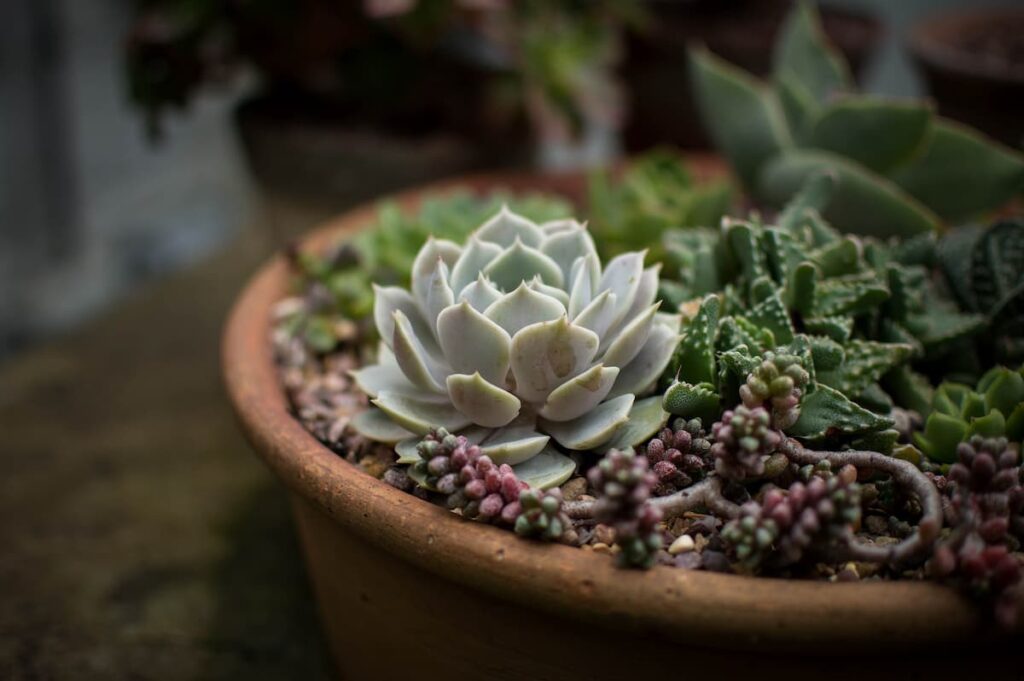
If you want to grow succulents at home, the most crucial thing is that succulents are very different from your regular indoor or outdoor plants. A large majority of houseplants, about 90%, are tropical plants and grow in forests where growing conditions are rich and moist. On the other hand, all succulent desert plants grow with very little water throughout the year except during the rainy season and loose sandy soil devoid of any organic matter.
Types of succulents in India
Best succulents for the Indian climate
Aloe Vera
Aloe is a stemless succulent plant with thick, fleshy leaves with serrated margins. Although it grows wild in several tropical climates, it also grows indoors successfully as a potted plant. It is relatively resistant to most pests. A moderate level of care is needed to ensure it doesn’t shrivel with too much water or burn out in too much sunlight. The plant needs bright, sunny conditions to grow well. Please place it under windows facing south or west. You can place it on the windowsill during the day and take it inside afterward.
Snake plant
This traditional succulent houseplant appears to be practically invincible and easiest to maintain. Snake plants can persist for weeks without water or light without losing their charm. Their three-foot-long, thick, rigid, pointed leaves often have a snake-like pattern and grow straight up. It will eventually grow into a larger clump that fills the entire pot but is easier to split and repot as needed. Despite tolerating low light, snake plants look their best in medium to bright light. Additionally, they need a little water whenever the soil appears dry.
Adenium
Adeniums grow to a height of 10 feet when planted in the ground but are smaller when grown in pots and containers. A beautiful choice to add a splash of color to the garden, Adenium flowers bloom for several weeks in shades of pink during the spring and summer months. Special care is necessary for the presence of children and pets.
In case you missed it: How to Add Nitrogen and Calcium to Your Garden Soil: A Must Guide for Gardeners
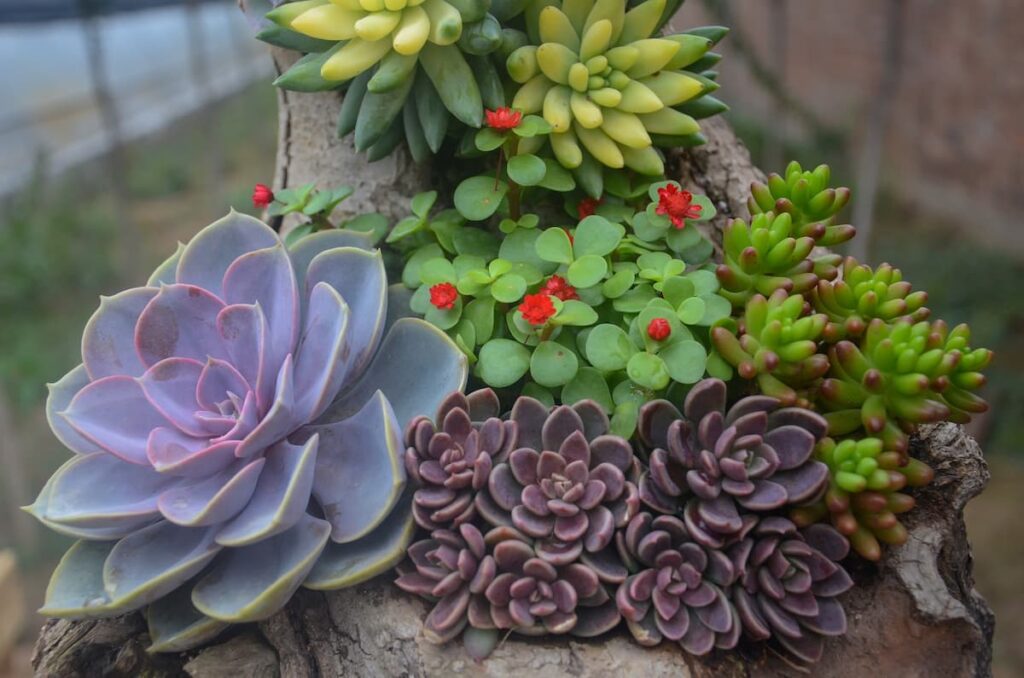
Moon Cactus / Ruby Ball Cactus
In India, Moon Cactus is the most beautiful succulent plant. The Moon Cactus is the best indoor succulent that grows well in indirect sunlight and cannot tolerate direct sunlight. It would help if you watered it at intervals of 10 to 15 days.
Crown of Thorns
This succulent gets its name because of the countless Thorns that spread its entire form. This plant has very little maintenance and only demands sunlight. This makes a great addition to your windowsill.
Agave
Agave is a hardy evergreen succulent, 4 feet long, forming a large rosette of narrow, stiffly straight leaves with moderately spaced spines. They are slow-growing, dramatic plants that stand out in the landscape. They even thrive on a bit of negligence.
Christmas Cactus
Christmas Cactus is the most beautiful succulent plant; it looks good even without flowers. You should keep the top 2 inches of soil dry between watering. Keep the plant on the dry side during winter. When it’s in the bud phase, be careful because even a little more water or lack of water can lead to the dropping of the buds.
Stone Crop
This plant is a creeper and grows well with some direction. If you’re creating a small green and arts space for yourself, you can choose to maintain it indoors or even on your balcony or terrace. The Stone Crop grows flowers of different colors, including pink, white, purple, yellow, and even red. That’s why you have a wide variety to choose from.
Lithops
Lithops are unique small and succulent plants that look like stone or pebbles. Growing Lithops is very simple and does not require much care. Place the plant in a sunny place; the south or west-facing window would be best, away from the draft. Grow Lithops in poor, well-drained soil. Stop watering your Lithops plants in the winter.
In case you missed it: How to Grow Cardamom (Elaichi) from Seeds at Home: Soil, Germination, Planting, Pests, Diseases, and Care
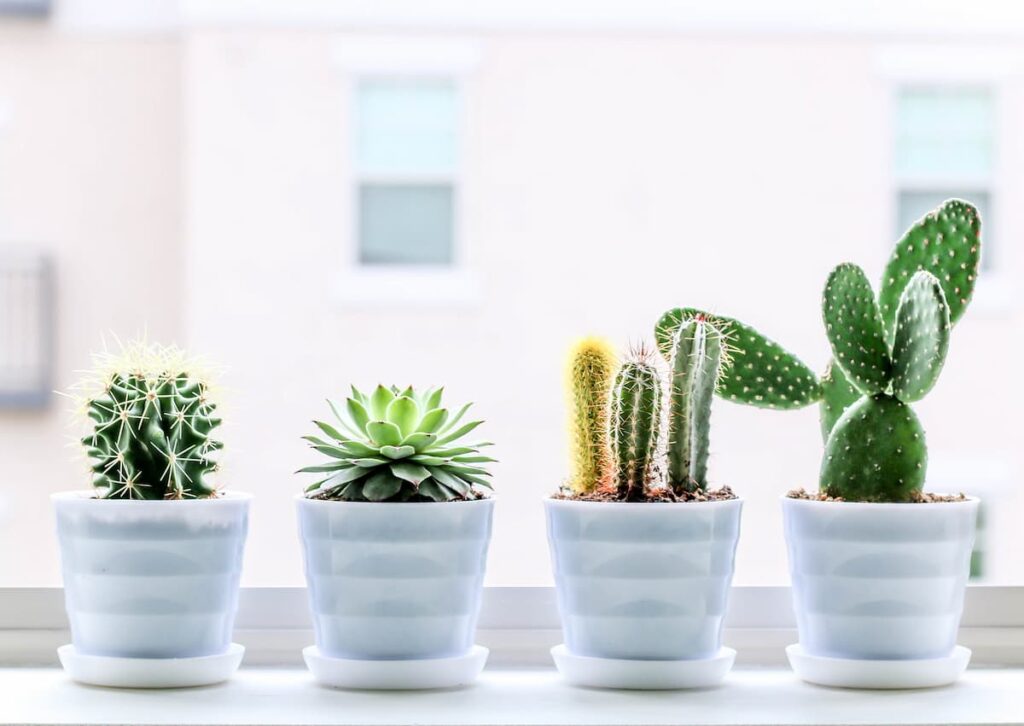
Hens and Chick
The plant grows a large rose known as a Hen and is surrounded by small rose-like leaves called Chicks. This plant makes an attractive addition to your office desk.
String of Bananas
This succulent plant produces long tendrils of tiny banana-like leaves. When grown alone, the plant has an excellent appearance and needs to be clipped repeatedly to be thick and full. It also looks fantastic when placed in a planter with other succulent houseplants. Filtered sunlight is needed. When the soil feels dry by touching and watering the plant, it thrives in permeable soil with good drainage. Because it is toxic, you should keep it away from children and pets who may try to eat it.
Hoya
Keep this stunning succulent plant indoors in your living space. This will attract much appreciation, especially when it’s in full bloom. Its leaves are quite large in size and have a heart shape. When red and pink flowers bloom, they give a pleasant scent that brightens the place.
Panda plant
Panda plant leaves are as thick as other succulents, and the edges have a rusty color; like many other plants, this plant also produces flowers. However, they rarely bloom in indoor conditions. It is a good idea to place the Panda plant in a place that receives a few hours of bright indirect light and direct sunlight. Occasionally water and let the plant dry between watering. During the growing season, you should feed the plant once a month. Protect the plant from frost and drought; the normal room temperature is perfect.
Pencil Cactus
Pencil Cactus has become one of the most popular succulent houseplants for the past few years. Place the plant near the sunny window. Water every two weeks, the plant has fewer water requirements. Repot the plant every year or when you find it rootbound.
Senecio
Senecio is a fast-growing succulent with vines that can reach a length of at least 3 feet. Once established, they endure extremely dry, with small, white, cinnamon-scented flowers.
In case you missed it: How to Choose the Right Soil Testing Meter for Your Garden: Best 20 Soil Testing Meters/Kits in India
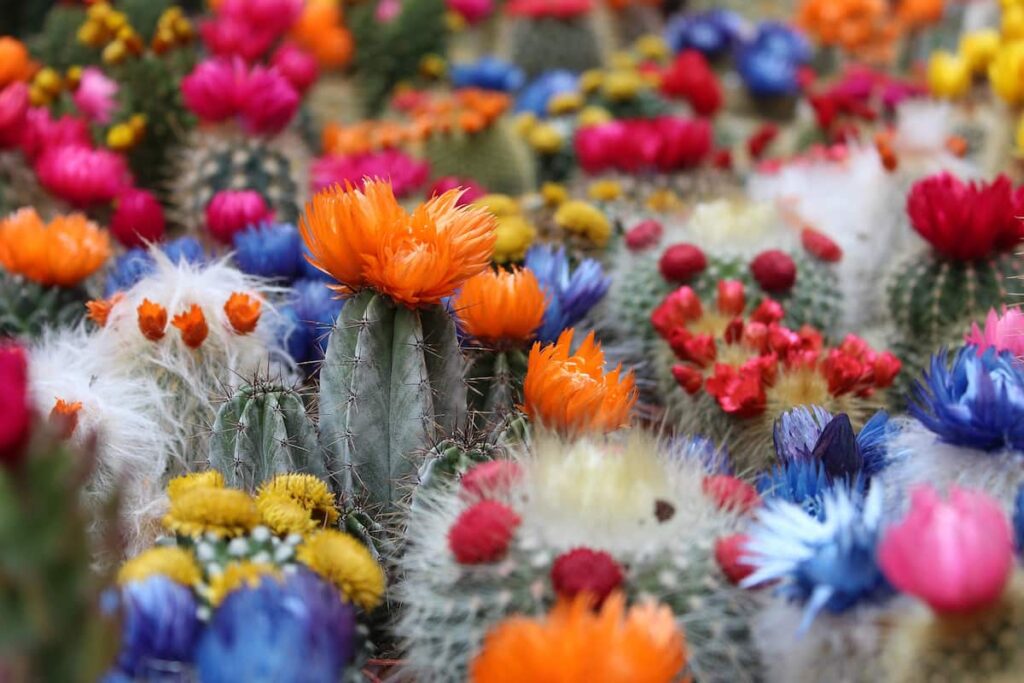
Adenium
Adeniums grow to a height of 10 feet when planted in the ground but are smaller when grown in pots and containers. A beautiful choice to add a splash of color to the garden, Adenium flowers bloom for several weeks in shades of pink during the spring and summer months. Adenium juice is toxic, and special care is necessary for the presence of children and pets.
Succulent plant care in India
The best container for your succulent
Succulents don’t need big pots/containers. The most important factor when choosing a container for your succulent is drainage. Succulent planters require a large drainage hole for quick drainage after watering them. To avoid calcium stains on their leaves or branches, you should always water them sidewise on the roots and not directly from the top. Do not overwater or underwater the plants, as it can stop their growth. When picking a container to rearrange your succulent plants, make sure the pot has a drainage hole and is larger than the previous pot.
Water requirements for succulents
Remember, succulents can rot and die if you give them more water. More often than not, succulents die from overwater than underwater. Only water the soil when the soil is dry. The practice of watering them once a week is healthy. Succulents maintain water in their leaves. Smaller ones can live up to 3 to 4 weeks without water, while larger ones can live for 4 to 5 months. However, they can die if the succulents are not watered after this time.
Succulents don’t need to be watered regularly; they work better on the drying side and are extremely drought resistant. They only need to be watered when the potting mixture is completely dry. If there is even a little moisture in the soil, it does not need any water. Succulents relax in the afternoon, and that’s when they absorb and utilize the water. It is essential to water the succulent from the side. Water your succulent until it comes out of the drainage hole, and let it drain completely.
The proper soil for your succulents
Succulent requires good drainage soil, a growing medium that doesn’t contain moisture. During soil preparation, add sand and volcanic rocks, and even spread out some pebbles to ensure a proper drainage system. The potting mix needs to be well-ventilated, and the roots breathe to avoid rotting. A loose mixture enables the weak root system to thrive and easily make its way through the planter, as the healthy root system translates to healthy shoot growth.
A well-draining loose mixture also ensures that it doesn’t hold excess moisture. A good succulent potting mixture should contain equal part building materials and drainage materials. Perlite, coarse sand, wood chips, neem-cake powder, compost, and cocopeat are great ingredients. Mix them in equal parts, and it’s good for you to go, or you can avoid all the trouble and buy a succulent potting mixture.
In case you missed it: 13 Beneficial Insects for Your Garden: Best List for Your Plants
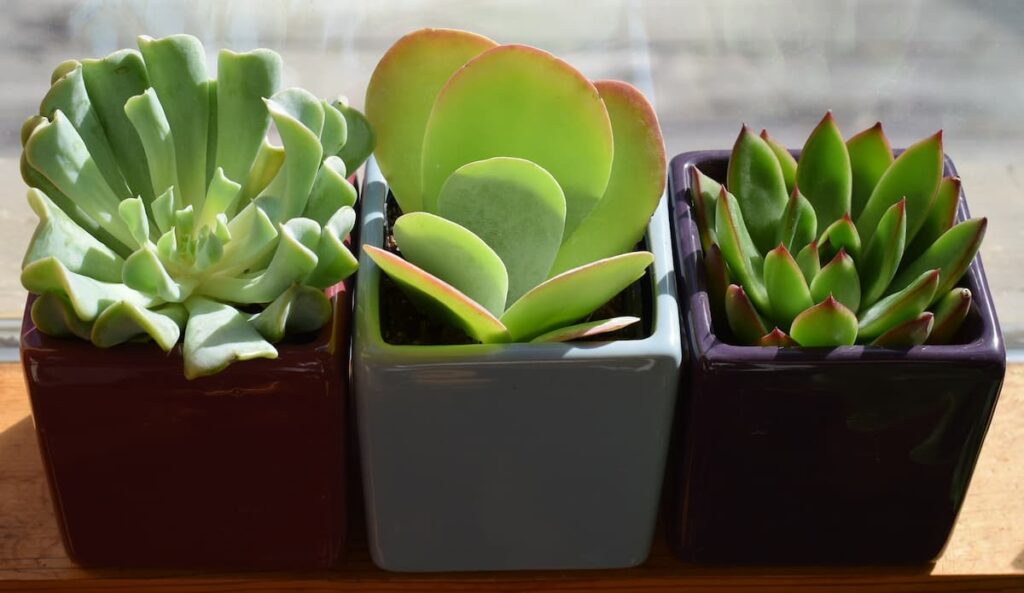
The right light for your succulent
Most of the plants in nurseries are maintained under the greenhouse. Once you’ve taken the plants home, please don’t put them directly in the sun; put them in it easily. Introduce them to the partial sun and then gradually to the full sun. Though most are good with the sun, they can’t tolerate the scorching sun of Indian summer afternoons.
They do great with 3 to 4 hours of sunlight outdoors and the brightest indirect lights indoors. Ideal locations indoors for them would be near south-facing windows or balconies or facing balconies or windowsills in the east or west where they get the morning or afternoon sun. Insufficient light will make the plant taller. Good lighting ensures better growth and brilliant colors.
Ventilation for your succulent
Succulent requires good ventilation, especially in the winter when it needs to breathe. Non-ventilated containers and places can suffocate plants and cause them to rot due to moisture build-up. Make sure the air flows freely around the succulent, and do not group them with other tropical houseplants as they increase the moisture content in the air around them. Good air circulation prevents diseases and keeps plants free from infection.
The right temperature for your succulent
Succulents are hardy plants that thrive at the maximum temperature range between 15°C to 30°C degrees. They become dormant in winter and require even less water to survive.
The right fertilizer for your succulent
Succulents require diluted fertilizer in their growing season (spring and summer). Feeding it once a month with any generic plant fertilizer does the trick. Spray one teaspoon of bone meal each month or a bi-monthly dose of 19:19:19 N:P: K foliar spray.
Keep free from bugs
Succulents are mostly free from pests. Pests can be a problem, however, plus mealybugs and spider mites are two types of pests that you need to be careful about. They can be picked by hand, or a neem oil spray will be enough to eliminate them.
In case you missed it: 365 Days Flowering Plants in India: A Year Of Beautiful Flowers
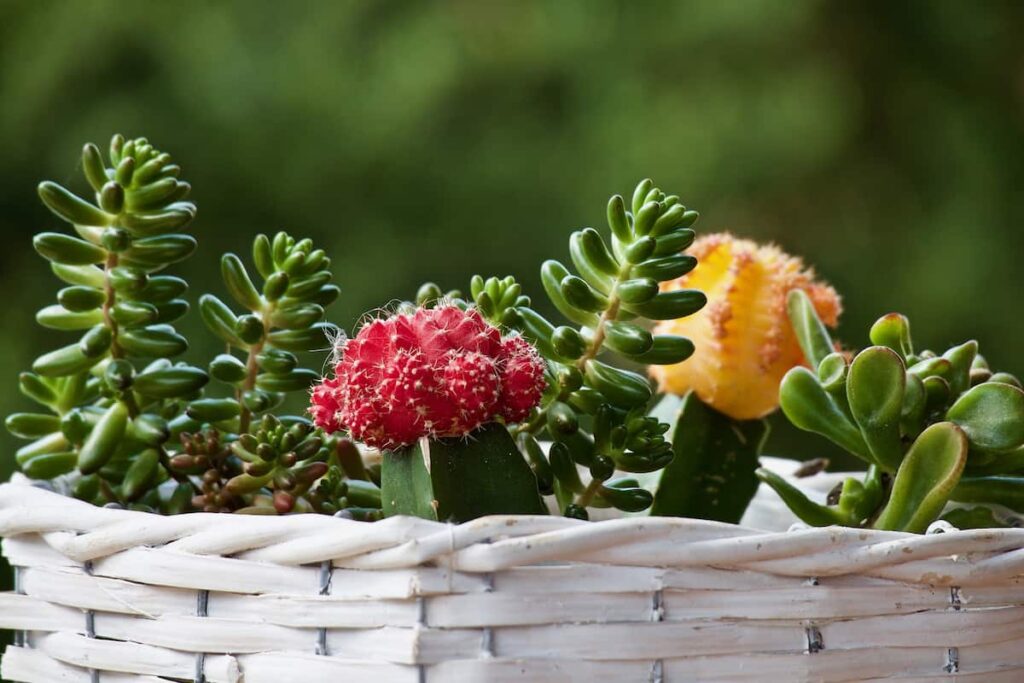
Winter care for your succulent
Succulents can’t survive in freezing temperatures, so don’t leave them outside. Moist soil can cause root rot in winter. This is why the use of water decreases further in the winter months. If the soil is not drying easily in winter due to moisture, add a layer of sand over the soil. If you don’t want the plant to move here and there, choose a location from 15°C to 20°C.
Conclusion
Succulents thrive in warm and dry climates because they can retain water. So, succulents grow well with indoor or outdoor plants will also grow in India, where it’s mostly hot throughout the year. The winter and spring seasons are the best seasons to start their growth. Native to arid regions, succulents are known for their thick and fleshy leaves, which retain water. Their increasing popularity among busy gardeners is that they are forgiven by nature, less caring, and ask little attention to growing. If you give them the proper care, they’ll survive very well.
- Flower Garden Designs and Layouts for Beginners
- Planting and Spacing Techniques in Papaya: A Beginner’s Guide
- Growing Gold: Essential Techniques for Planting Pineapples
- How to Make Kalanchoe Plant Bushy: Home Remedies and Solutions
- 11 Reasons Why Your Gardenia is Not Blooming: Home Remedies and Solutions
- Eco Elegance: The Guide to Designing a Drought-Tolerant Landscape
- Gardening on a Slope: Strategies for Hillside Landscaping
- Nourish and Flourish: Top Organic Mulches for Thriving House Plants
- Everything You Want to Know about Indian Mogra Flower: Discover Uses and Growing
- Green Thumb Success: Expert Tips for Cultivating Greenhouse Pumpkins All Year Round
- Maximize Growth & Flavor: The Ultimate Guide to Companion Planting in Herb Gardens
- How to Control Rhododendron Problems Naturally: Home Remedies and Organic Ways to Fix Them
- Natural Magic: The Remarkable Benefits of Cinnamon for Plants
- Best Steps to Revive Dying Tulip with Natural and Organic Treatment
- 10 Reasons Why Your Angel Trumpet is Not Blooming: Remedies and Treatment
- How to Fix Periwinkle Leaf and Flower-Related Problems: Natural Remedies and Solutions
- How to Fix Zinnias Leaf and Flower Problems: Discover Natural and Home Remedies
- Organic Steps to Induce Lemon Tree Flowers: A Comprehensive Guide
- Bloom Booster: Crafting the Perfect Homemade Bougainvillea Fertilizer
- Optimizing Growth: A Guide to Applying NPK Fertilizer for Potted Plants
- 10 Best Homemade Fertilizers for Rubber Plant: DIY Recipes and Application Method
- How to Boost Female Pumpkin Flowers: Effective Steps for More Flowers and High Yields
- Transform Your Indoor Garden: Top Benefits of Pink Salt for Houseplants
- 10 Best Homemade Fertilizers for Peacock Plants (Calathea): Easy DIY Guide
- Unlock Blooms: 9 Reasons Why Your Potted Chrysanthemum is Not Blooming
- 8 Reasons Why Your Potted Hibiscus is Not Blooming: Fix it with Simple Solutions
- Unlock Blooms: 9 Key Reasons Your Potted Frangipani Won’t Flower
- 10 Reasons Why Is My Ice Plant Not Blooming: Remedies and Treatment
- 10 Reasons Why My Potted Hydrangea Not Blooming: Treatment and Remedies
- 10 Reasons Why is My Wisteria Not Blooming: Remedies and Treatment
- 10 Reasons Why is My Goldfish Plant Not Blooming: Remedies and Treatment
- Maximize Your Space: Ultimate Guide to Balcony Gardening with Grow Bags
- 10 Reasons Why Your Iris is Not Blooming: Remedies and Treatment
- 10 Reasons Why Your Anthurium Plant is Not Blooming: Treatment and Remedies
- 10 Reasons Why Your Aquaponic Plants Are Not Flowering: Remedies and Treatment
- 10 Reasons Why Your Agapanthus is Not Flowering: Remedies and Treatment